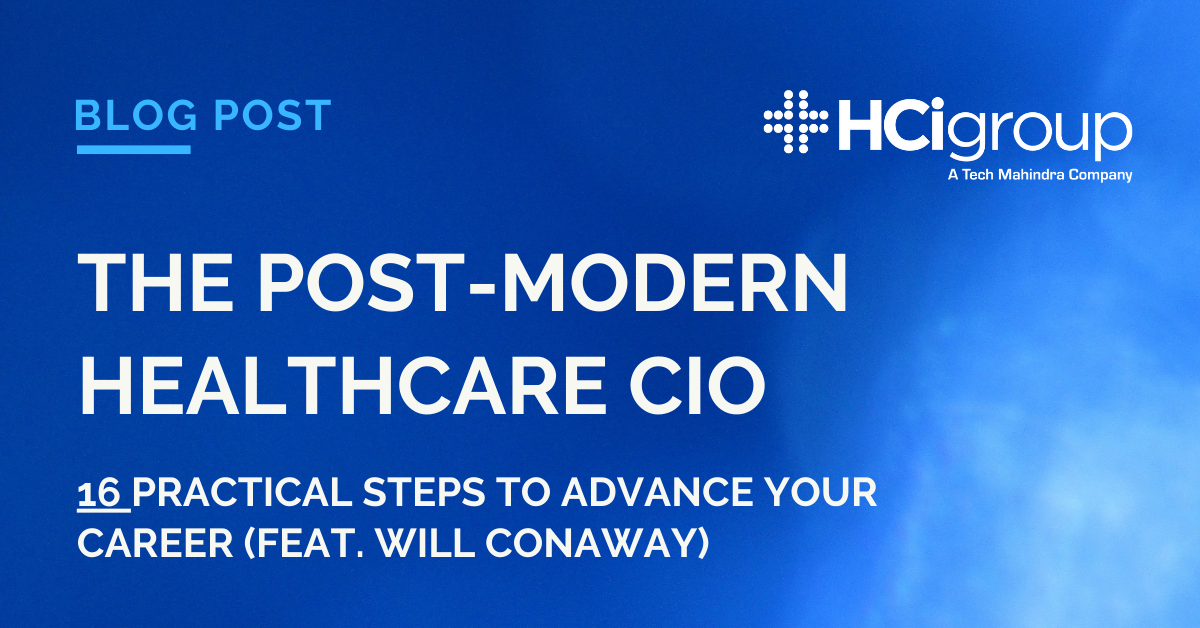16 Practical Steps to Advance Your Career as a Healthcare CIO (Feat. Will Conaway)


A C-suite executive leader of all things digital, the post-modern healthcare CIO is as literate and comfortable with technology as they are with clinical, operations, and finance.
Traditionally confined to managing IT, CIOs have been increasingly looked to for strategy and leadership beyond their departments as healthcare organizations have transformed themselves during the COVID-19 pandemic.
“In healthcare, surmounting unprecedented challenges positioned CIOs to reframe their mission to suit new realities. Their role is revitalized as an agile master of information — a true business hero,” notes a Forbes article on how the role of CIO is changing.
Many healthcare CIOs have taken on new titles, like in shifting to chief digital officer, as organizations have recognized the importance of leading with technology rather than leaning on it for support. Yet many other organizations have hired CDOs from outside of the industry as they have identified new areas of focus for healthcare technology.
Given an organization's propensity to recruit outside of healthcare, becoming a leader that is transformational rather than transactional is essential to moving up internally or obtaining a more senior position elsewhere.
Advancing Your Career as a Healthcare CIO
Will Conaway, Chief Growth Office & VP of Provider Delivery at The HCI Group, offers the following suggestions for developing the knowledge and skills to become a post-modern healthcare CIO.
Approaching your job
1. Learn the industry.
Read about healthcare for at least one hour a week so that you know the latest trends, opportunities, and challenges. Also talk with those in healthcare to understand what they are experiencing. “You need to know how to tie technology to the overall health of the organization,” Conaway says.
2. Think holistically.
View the organization as a whole, seeing how people, processes, and strategies fit together.
3. Leverage technology.
Align technology with business objectives and organizational goals.
4. Translate technology.
Explain technology in its simplest terms so that others within the organization will understand, whether they are board members, executives, clinicians, or administrative staff.
5. Be realistic.
Know how the organization works.
6. Get involved.
Join industry organizations and position yourself as a leader by presenting on important topics whenever possible.
Developing yourself
7. Market yourself.
Form your value statement and communicate it clearly and consistently.
8. Network.
Develop a network of different types of people that help you, such as confidants and connectors.
9. Become a people person.
People skills become more important as you advance. Focus on your ability to work with others.
10. Study leadership.
Read — a lot. Conaway for one studies history, like leadership lessons from General George Marshall.
11. Give of yourself.
Mentor others. Share what others have taught as well as what you have learned.
Advancing your career
12. View yourself as a company.
Approach your career as you would a business. Create a strategic plan around your mission and vision statements as well as your goals and objectives.
13. Measure progress.
Include metrics in your career plan. “If you don’t measure something, you can’t control it,” Conaway says.
14. Adapt to changes.
Build contingencies into your plan and revise it as needed.” Conaway shares Publilius Syrus’ words: “It is a bad plan that admits of no modification.”
15. Connect with recruiters.
Form good relationships with executive recruitment firms.
16. Be patient.
Set a realistic timeframe for advancing. “Sometimes it’s a slow process,” Conaway says.
As the role of health IT leaders changes, CIOs need to focus more on business outcomes and innovation. They must also work across the organization instead of within the IT department.
Healthcare organizations have shown that they want technology leaders that can lead them into the future — and that they will hire from outside the industry if needed. If you don’t want to be stuck in a position or passed over for advancement, become the transformational leader that organizations want instead of the transactional manager that you have been.
Three Things Leaders Do
- Cultivate their network. Your network equals your net worth.
- Develop other leaders. Leaders replicate themselves because they understand that their success, and moreover their organization’s success, is predicated upon the continuous development of talent.
- Foster a culture of innovation and creativity. Leaders are culture warriors who remove the burden of bureaucracy.
